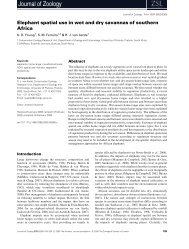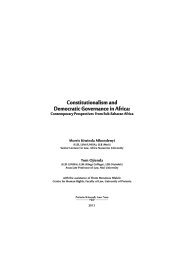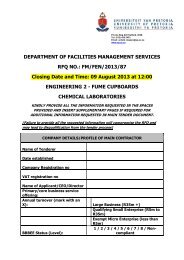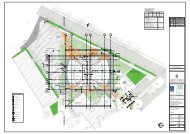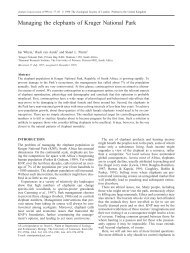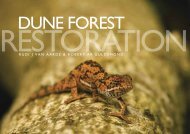Sexual Behavior of the Female Porcupine Hystrix ... - CERU
Sexual Behavior of the Female Porcupine Hystrix ... - CERU
Sexual Behavior of the Female Porcupine Hystrix ... - CERU
Create successful ePaper yourself
Turn your PDF publications into a flip-book with our unique Google optimized e-Paper software.
~~TABLE ILife History and Social Environment <strong>of</strong> <strong>Female</strong> <strong>Porcupine</strong>s Included in <strong>the</strong> Experimental Group (E) and Control Group (C)Age" Reproductive No, <strong>of</strong> Litter No. <strong>of</strong> days<strong>Female</strong> (months) status litters size since last estrus Conspecifics present"s::.'"'-'') :;0- :;0A (E) 32 Parous 208 2 juvenile <strong>of</strong>fspring. <strong>Female</strong> B(Lactating until4/23/82) >ZB (E) 31 Nulliparous 26 2 <strong>of</strong>fspring <strong>of</strong> <strong>Female</strong> A; <strong>Female</strong> AvC (E) 36 Parous 2 I + I 166 2 female <strong>of</strong>fspring; <strong>Female</strong> 0 Z5/25/82)>D (E) 36 Parous Unknown Unknown 136 2 <strong>of</strong>fspring <strong>of</strong> <strong>Female</strong> C; <strong>Female</strong> C >:;0E (C) 36 Nulliparous 23 Vasectomized Male E; Juvenile vF (E) 15 Parous 34 Single female juvenile <strong>of</strong>fspring mG (C) 22 Nulliparous 86 Male G; juvenile malea Age at beginning <strong>of</strong> <strong>the</strong> experimental period, 4/26/82. b Conspecifics present with <strong>the</strong> female over <strong>the</strong> entire experimental period, from 4/26/82 to 6/14/82. ::.rl
SEXUAL BEHAVIOR OF PORCUPINES403arena and Focal Animal Sampling (see Altmann, 1974) with <strong>the</strong> femaleas <strong>the</strong> focal subject, commenced as soon as both animals were in <strong>the</strong>arena. Clearly defined activities <strong>of</strong> <strong>the</strong> male toward <strong>the</strong> female were alsorecorded. The frequency <strong>of</strong> all and duration <strong>of</strong> most behavioral activitieswere recorded during a to-min sampling period. Recorded activities includingmarking (both subjects), approaching (both subjects), contact(both subjects), presenting (both subjects), mounting, grooming (self-,allo-, or mutual), following, and exploring.<strong>Behavior</strong>al definitions.Marking. Recorded whenever <strong>the</strong> subject dragged its perineal region along <strong>the</strong>surface <strong>of</strong> <strong>the</strong> testing arena or on a brick placed in <strong>the</strong> center <strong>of</strong> <strong>the</strong> arena. Markingwas <strong>of</strong>ten accompanied by urination.Approaching. Recorded whenever one <strong>of</strong> <strong>the</strong> subjects purposefully approachedto within approximately 0.5 m <strong>of</strong> <strong>the</strong> o<strong>the</strong>r.Contact. Recorded whenever one subject made physical contact with <strong>the</strong> o<strong>the</strong>r.Contact usually involved sniffing and investigatory behavior and was <strong>of</strong>ten succeededby a\lo- or mutual grooming.Grooming. Involved licking <strong>the</strong> head, flanks, or forepaws and was classified asei<strong>the</strong>r self-, allo-, or mutual grooming.Following. One individual walking behind (within approximately 30 em) <strong>the</strong> o<strong>the</strong>r.(This behavior <strong>of</strong>ten resulted in <strong>the</strong> male touching <strong>the</strong> female's tail with his nose,<strong>the</strong>reby eliciting lordosis in <strong>the</strong> female).Presenting. Recorded when ei<strong>the</strong>r animal exhibited lordosis. This was characterizedby an immobile posture with <strong>the</strong> erection <strong>of</strong> <strong>the</strong> quills and flattening <strong>of</strong> <strong>the</strong> backso that <strong>the</strong> body was close to <strong>the</strong> floor with <strong>the</strong> rump and tail raised (Fig. I).FiG. 1.<strong>the</strong> male.<strong>Female</strong> porcupine exhibiting lordosis in response to tactile stimulation from
404 MORRIS AND VAN AARDE-.l'Vl01lIltillg. The male standing bipcdally and resting his forepaws on <strong>the</strong> female'sback (Fig. 2). Thrusting occlirred during intromission.E,plorillg, Any activity. besides those previously described. and excluding sittingmotionless or resting. This behavior usually t()ok <strong>the</strong> (orm <strong>of</strong> investigating <strong>the</strong>test arena,<strong>Sexual</strong> behavior is here defined as all behavioral activities <strong>of</strong> <strong>the</strong> femaleor male toward <strong>the</strong> male and female, respectively, and includes approach,contact, presenting, and mounting. Copulatory behavior included all <strong>of</strong><strong>the</strong>se except that mounting was followed by copulation.Determination (~r plasma /(')'cls (~r stcroid hOl'lllOnes. Blood samples(5.0 mn were collected from immobilized females through cardiac punctureon <strong>the</strong> day following <strong>the</strong> behavioral test session. <strong>Female</strong>s were immobilizedthrough an intramuscular injection <strong>of</strong> a mixture <strong>of</strong> xylazine hydrochloride(Rompun; Bayer, Leverkusen. F.R.C.) and ketamine hydrochloride(Ketalar; Parke-Davis Laboratories (pty) Ltd., lsando, S. Africa) at amean dose. rate <strong>of</strong> 1.6 ± 0.29 mg/kg (11 = 57) Rompun and 5.5 ± 0.64mgjkg (11 = 61) Ketalar.Plasma fractions collected from heparinized centrifuged blood sampleswere stored at - 20°C within 1 h <strong>of</strong> sampling until assayed for progesteroneand estradiol-17,B levels.The procedure used to measure plasma levels <strong>of</strong> progesterone Viassimilar to that <strong>of</strong> Haresign. Foster, Haynes. Crighton, and Lamming(1975) using antiserum raised in a goat to progcsterone- I I-succinyl-bovineserum albumin as described by Furr (1973) and supplied by SpecificAntisera Ltd. (Wilmslow, U.K.)The specilicity <strong>of</strong> <strong>the</strong> antiserum was described by Fun (1973). SensitivityFIG. 2.The mOllllting postlIre in <strong>the</strong> porcupine !1\'strix ({fi·ic(lcolIslralis.
406 MORRIS AND VAN AARDEcomponents <strong>of</strong> sexual behavior) displayed by a female was relativelyconstant and apparently not affected by her hormonal status. However,<strong>the</strong> time spent on sexual activities by experimental <strong>Female</strong> A (representedas a percentage <strong>of</strong> <strong>the</strong> total observation time) changed during <strong>the</strong> cycle(Fig. 3) with <strong>the</strong> duration <strong>of</strong> contact, presentation, and mounting allpeaking on Day o. No definite pattern existed for experimental <strong>Female</strong>sBand C (Fig. 3) and <strong>the</strong> control females (Fig. 4). Receptivity scores("lordosis" or copulatory quotients; see Beach, 1943) did not changeduring estrus, suggesting that female receptivity remained relatively constantthroughout <strong>the</strong> cycle.Sexu.al and Copulatory <strong>Behavior</strong><strong>Female</strong>s in <strong>the</strong> experimental groups initiated most <strong>of</strong> <strong>the</strong> sexual behaviorwhile males initiated most sexual behavior in <strong>the</strong> control groups. Initiation<strong>of</strong> sexual behavior in <strong>the</strong> experimental groups commenced most <strong>of</strong> <strong>the</strong>time with <strong>the</strong> female approaching <strong>the</strong> male, followed by mutual groomingand, when not ignored by <strong>the</strong> male, by presentation (lordosis). Presentationwas, however, sometimes initiated by <strong>the</strong> male touching <strong>the</strong> posteriorregion <strong>of</strong> <strong>the</strong> female with his nose. This was <strong>the</strong>n followed by <strong>the</strong> maleei<strong>the</strong>r ignoring <strong>the</strong> female or mounting <strong>the</strong> female, with intromission onlyoccurring during estrus. The sequence <strong>of</strong> events occurring during sexualbehavior could be interrupted at all stages by ei<strong>the</strong>r <strong>of</strong> <strong>the</strong> two participantsbreaking contact by moving away from <strong>the</strong> o<strong>the</strong>r.A copulation observed under experimental conditions lasted 154 secwith 38 thrusts followed by ejaculation, being terminated by <strong>the</strong> maledismounting. Receptivity lasted approximately 9 hr. The copulatory plugwas expelled 48 hr later.Experimental females approach males significantly more frequentlythan being approached by <strong>the</strong>ir males (X 2 = 43.4; P(2) < 0.5). <strong>Female</strong>salso marked more frequently than <strong>the</strong>ir male counterparts (X 2 = 44.4;P(2) < 0.5). In contrast, control females were more frequently approachedby <strong>the</strong>ir males which also marked more frequently than <strong>the</strong> femalesexcept when control females were in estrus. Limited sample sizes precludedmeaningful statistical comparisons.The behavior <strong>of</strong> a specific male toward <strong>the</strong> females to which he hadbeen habituated before <strong>the</strong> onset <strong>of</strong> <strong>the</strong> observation period also differedmarkedly: Male A approached <strong>Female</strong> A 5.6 times as <strong>of</strong>ten as he approached<strong>Female</strong> B, with <strong>Female</strong> A approaching Male A 1.2 times as <strong>of</strong>ten as<strong>Female</strong> B did. The ratio <strong>of</strong> <strong>the</strong> number <strong>of</strong> male: female approaches observedthroughout <strong>the</strong> study period suggests that this male had a preference for<strong>Female</strong> A.DISCUSSIONComponents <strong>of</strong> sexual behavior occurred throughout <strong>the</strong> estrous cycleand appear not to be affected by <strong>the</strong> reproductive status and hormonal
SEXUAL BEHAVIOR OF PORCUPINES407wZ~IIIlI/)w(!)orrQ..3,01,0-5 0 5___ .. Estradiol-17B/"--Progeste;15 25 0 5~-- ... Contact.... - - ... Presentingzo~30 -Mountin,9rr~cu.o108,0wZo a::wlI/)4,0III(!)oa::Q..~I/400-5 5 15 25 o 5<strong>Female</strong> B,:\ 200" \:, \:, 1 \ \J \200 II>~,w '"\ 100'"\,1I, \ ~,I " ~ \ \ ... ': \ \ w'"-5 0 5 15 0 5 15z >o Ii= :;.q; j:a:: u:::l «Cu.#. o30105,0IIIZ~III 3,0lI/)IIIC)oa::0. 1,0-5 0 5 15 0 5 15<strong>Female</strong> C,,. 400II: II "I,",f II100 c:>I...., I -,-5 C? 5 15 ~ 5NIIIz >o !:: 15>~ j:a::::la~u. 5o'"~It\ ,J:; ,"\ 1\ /\ t-'k../ '\/ ,/\ \1": II '\ \ ,/ \~ ll: \I" V v' ; ~ -5 0 5 15 o 5 DAYS OF ESTROUS CYCLEFIG, 3. Circulating levels <strong>of</strong> plasma progesterone (ng/ml) and estradiol-17{3 (pg/ml),and duration (percentage <strong>of</strong> total observation time) <strong>of</strong> reproductive activities in experimentalfemale porcupines throughout <strong>the</strong> experimental period. Day 0 denotes <strong>the</strong> day when vaginalopening was first observed, i.e., estrus.
SEXUAL BEHAVIOR OF PORCUPINES409Differences between sexual and copulatory behaviors in <strong>the</strong> porcupineare subtle. They are associated with intromission which can only occurat estrus when <strong>the</strong> vaginal membrane is perforated. A close parallel toour distinction between sexual and copulatory behavior has been illustratedfor <strong>the</strong> pigtale macaque Macaca nemestrina (Bullock et at., 1972) wherepatterns <strong>of</strong> sexual behavior changed little during <strong>the</strong> menstrual cycle,yet <strong>the</strong> occurrence <strong>of</strong> ejaculation and sex skin swelling were coincident.The high frequencies at which experimental females and males approachedand contacted each o<strong>the</strong>r is probably an artifact <strong>of</strong>experimentalconditions; isolation between test sessions would conceivably stimulateintersexual interest. Control animals which were kept in <strong>the</strong> same enclosurethroughout <strong>the</strong> study period also approached and contacted each o<strong>the</strong>rduring most test sessions throughout <strong>the</strong> study period although at a muchlower frequency than <strong>the</strong> experimental animals. The only change in thisbehavior during <strong>the</strong> estrous cycle was <strong>the</strong> increase in approaches madetoward <strong>the</strong> male by a control female (<strong>Female</strong> G) during estrus. Thisprobably reflects typical behavior under natural conditions with <strong>the</strong> femaleshowing more interest in <strong>the</strong> male during estrus than met-estrus.Kleiman (1974) states that a high level <strong>of</strong> aggression is common inreproductively active but nonreceptive hystricomorph females. As a result<strong>of</strong> <strong>the</strong> morphological characteristics and <strong>the</strong> presence <strong>of</strong> sharp posteriorlydirected qUills, appeasement and solicitation may be considered vitalprerequisites for mounting in <strong>the</strong> Cape porcupine. Although female porcupinesincluded in this study were aggressive towards strange males,<strong>the</strong>y never exhibited any form <strong>of</strong> aggression (i.e., tail rattling, food stamping,or quill erection) towards males with whom <strong>the</strong>y had cohabited beforeor during <strong>the</strong> period <strong>of</strong> observation. Appeasement was <strong>the</strong>refore notrequired, and <strong>the</strong> absence <strong>of</strong> a complicated courtship ritual in male porcupinesmay thus be ascribed to a lack <strong>of</strong> female aggression. Sinceaggression could prove discomforting to <strong>the</strong> male, which actively participatesin <strong>the</strong> rearing <strong>of</strong> <strong>the</strong> young (van Aarde, 1984), lack <strong>of</strong> aggressiontowards a known male will conceivably have a selective advantage for<strong>the</strong> female.The incidence <strong>of</strong> aggression, or lack <strong>the</strong>re<strong>of</strong>, in <strong>the</strong> porcupine duringstaged encounters is reminiscent <strong>of</strong> <strong>the</strong> situation described by Gctz,Carter, and Gavish (1981) for <strong>the</strong> prairie vole Microtus achrogaster. Inlaboratory encounters, both male and female voles from breeding pairstended to show relatively high levels <strong>of</strong> aggression toward unfamiliaranimals <strong>of</strong> <strong>the</strong> opposite sex. In contrast, aggression was rarely observedbetween members <strong>of</strong> established breeding pairs (Getz et al., 1981). Theseresults were used as partial evidence for pair-bonding in <strong>the</strong> prairie vole,and <strong>the</strong> similar evidence available for <strong>the</strong> porcupine may also be indicative<strong>of</strong> pair-bonding.Kleiman (1971) reported that when several adults <strong>of</strong> both sexes <strong>of</strong>
410 MORRIS AND V AN AARDEgreen acouchis are housed toge<strong>the</strong>r, individual males and females tendto form pair-bonds. Kleiman (1971) also found that during observations<strong>of</strong> one group <strong>of</strong> six acouchis (three females, three males), each maledirected most <strong>of</strong> his courting activity toward one female. A similar trendis apparent in <strong>the</strong> porcupine; <strong>the</strong> greater number <strong>of</strong> approaches directedby Male A to <strong>Female</strong> A than to <strong>Female</strong> B, irrespective <strong>of</strong> <strong>the</strong> estralstatus <strong>of</strong> <strong>the</strong> female, illustrates this point. Moreover, comparing breedingsuccess <strong>of</strong> <strong>the</strong>se two females, <strong>Female</strong> A conceived and brought to termtwo <strong>of</strong>fspring, whereas <strong>Female</strong> B, although sexually mature, was stillnulliparous at <strong>the</strong> end <strong>of</strong> <strong>the</strong> study. Similarly, <strong>Female</strong> C conceived twiceand produced two <strong>of</strong>fspring, yet <strong>Female</strong> D, although parous, has neverconceived while housed with <strong>Female</strong> C and Male B. Again, this phenomenonin <strong>the</strong> porcupine can be likened to that in <strong>the</strong> green acouchiwhere young were conceived more quickly, brought to term, reared, andweaned when animals were housed in pairs (Kleiman, 1971).<strong>Sexual</strong> behavior and various o<strong>the</strong>r interactive activities have frequentlybeen identified as streng<strong>the</strong>ning <strong>the</strong> pair-bond (Erickson, 1978), and thisis a possible explanation for <strong>the</strong> persistence <strong>of</strong> such activities throughout<strong>the</strong> estrous cycle <strong>of</strong> <strong>the</strong> porcupine.Kleiman (1974) suggests that <strong>the</strong> shortness <strong>of</strong> <strong>the</strong> receptive period inmost hystricomorph rodents could explain <strong>the</strong> persistent courtship <strong>of</strong> <strong>the</strong>male and his increased attention given to <strong>the</strong> female during proestrus.Lisk (1978) states that <strong>the</strong> maximum duration <strong>of</strong>sexual heat for all speciesexamined is 15% <strong>of</strong> <strong>the</strong> estrous cycle length. In sheep, with an estrouscycle <strong>of</strong> 16 days, sexual behavior lasts for approximately 24 hr. In <strong>the</strong>guinea pig, with <strong>the</strong> same cycle length, estrus lasts for 8-10 hr. Yet in<strong>the</strong> porcupine, with a cycle length <strong>of</strong>30 days, behavioral estrus (or sexualheat) lasts for approximately 9 hr (1.23% <strong>of</strong> <strong>the</strong> cycle length). This shortperiod <strong>of</strong> receptivity <strong>of</strong> <strong>the</strong> female could also explain <strong>the</strong> maintenance<strong>of</strong> sexual activity on <strong>the</strong> part <strong>of</strong> <strong>the</strong> male throughout <strong>the</strong> estrous cycle.CONCLUSION<strong>Sexual</strong> activity occurs throughout <strong>the</strong> estrous cycle and <strong>the</strong>refore doesnot reflect <strong>the</strong> hormonal status <strong>of</strong> <strong>the</strong> female porcupine.A distinction can be made between sexual behavior and copulatorybehavior, with <strong>the</strong> latter occurring only during estrus when <strong>the</strong> vaginalclosure membrane <strong>of</strong> <strong>the</strong> female is perforated. Although some components<strong>of</strong> copulatory behavior occur throughout <strong>the</strong> cycle, complete copulationswith intromission occur only during estrus. The only indications <strong>of</strong> increasedreceptivity <strong>of</strong> <strong>the</strong> female during estrus are increased female: male approachesand an increased duration <strong>of</strong> female: male contact.There is considerable evidence indicating that in captivity porcupinesform pair-bonds. These include (i) <strong>the</strong> lack <strong>of</strong> aggression shown by femalesto known males (as opposed to <strong>the</strong> aggression shown to strange males),
SEXUAL BEHAVIOR OF PORCUPINES411(ii) <strong>the</strong> greater interest shown by males towards certain females, and(iii) <strong>the</strong> superior breeding success <strong>of</strong> <strong>the</strong> females referred to in (ii) above.Whe<strong>the</strong>r pair-bonding is <strong>the</strong> operative mating system in <strong>the</strong> wild isunknown, yet <strong>the</strong>ir reproductive behavior suggests that this might be <strong>the</strong>case.ACKNOWLEDGMENTSOne <strong>of</strong> us, D. J. Morris, was a recipient <strong>of</strong> a Council for Scientific and Industrial Researchbursary. We gratefully acknowledge <strong>the</strong> assistance provided by Denvin Majola.REFERENCESAbraham, E. G. (1976). Radioimmunoassay <strong>of</strong> oestradiol-l7J3 in plasma. In H. Breuer, D.Hamel, and H. L. Kriiskemper (Eds.), Methods afHormone Analysis. George ThiemeVerlag, Stuttgart.Altmann, J_ (1974). Observational study <strong>of</strong> behaviour: Sampling methods. Behaviour 49,221-267.Beach, F. A. (1943). Effects <strong>of</strong> injury to <strong>the</strong> cerebral cortex upon <strong>the</strong> display <strong>of</strong> masculine and feminine mating behaviour by female rats. J. Compo Psychol. 36, 169-198. Beach, F. A. (1976). <strong>Sexual</strong> attractivity, proceptivity, and receptivity in female mammals. Horm. Behav. 7, 105-138.Bignami, G., and Beach, F. A. (1968). Mating behaviour in <strong>the</strong> chinchilla. Anim. Behal'.16,45-53.Birke, L. I. A. (1981). Some behavioural changes associated with <strong>the</strong> guinea-pig oestrouscycle. Z. TierpsycllOl. 55, 79-89.Bullock, D. W., Paris, C. A., and Goy, R. W. (1972). <strong>Sexual</strong> behaviour, swelling <strong>of</strong> <strong>the</strong>sex skin and plasma progesterone in <strong>the</strong> pigtail macaque. J. Reprod. Ferti/. 31, 225236.de Graaff, G. (1981). The Rodents <strong>of</strong> SOli/hem Africa. Butterworths, Pretoria, S. Africa.Erickson, C. J. (1978). <strong>Sexual</strong> affiliation in animals: Pair bonds and reproductive strategies.In J. B. Hutchinson (Ed.), Biological Determinants (~r <strong>Sexual</strong> Behaviour, pp. 697726. Wiley, Chichester.Furr, B. J. A. (1973). Radioimmunoassay <strong>of</strong> progesterone in peripheral plasma <strong>of</strong> <strong>the</strong>domestic fowl in various physiological states and in follicular venous plasma. ActaEndocrinol. (Copenhagen) 72, 89-IOO.Getz, L. L., Carter, C. S., and Gavish, L. (1981). The mating system <strong>of</strong> <strong>the</strong> prairie vole,Microtus achrogaster: Field and laboratory evidence for pair-bonding. Bellav. Ecol.Sociobiol. 8, 189-194.Haresign, W., Foster, J. P., Haynes, N. B., Crighton, D. B., and Lamming, G. E. (1975).Progesterone levels following treatment <strong>of</strong> seasonally anoestrous ewes with syn<strong>the</strong>ticLH-releasing hormone. J. Reprod. Fertil. 43, 269--279.Kleiman, D. G. (1970). Reproduction in <strong>the</strong> female green acouchi, Myoprocta pratti Pocock.J. Reprod. Fertil. 23, 55-65.Kleiman, D. G. (1971). The courtship and copulatory behaviour <strong>of</strong> <strong>the</strong> green acouchi,Myoprocta pratti. Z. Tierpsychol. 29, 259-278.Kleiman, D. G. (1974). Patterns <strong>of</strong> behaviour in hystricomorph rodents. Symp. Zool. Soc.London 34, 171-209.Lisk, R. D. (1978). The regulation <strong>of</strong> sexual 'heat.' In 1. B. Hutchinson (Ed.), BiologicalDeterminants ~r <strong>Sexual</strong> Behaviour, pp. 425-466. Wiley, Chichester.Nadler, R. D., Collins, D. C., Miller, L. c., and Graham, C. E. (1983). Menstrual cyclepatterns <strong>of</strong> hormones and sexual behaviour in gorillas. Hortn. Belial'. 17, 1-17.
412 MORRIS AND VAN AARDERood, J. P., and Weir, Barbara J. (1970). Reproduction in female wild guinea-pigs. J.Reprod. Fertil. 23, 393-409.Shideler, S. E., Lindburg, D. G., and Lasley, B. L. (1983). Estrogen behaviour correlatesin <strong>the</strong> reproductive physiology and behaviour <strong>of</strong> <strong>the</strong> ruffed lemur (Lemur variegatus).Horm. Behav. 17, 249-263.Smi<strong>the</strong>rs, R. H. N. (1983). The Mammals <strong>of</strong> <strong>the</strong> Sou<strong>the</strong>rn African Subregion, pp. 186188. University <strong>of</strong> Pretoria, Pretoria, S. Africa.van Aarde, R. J. (1984). Reproduction il1 <strong>the</strong> porcupine <strong>Hystrix</strong> ((friclIeallstralis Peters.D.Sc. <strong>the</strong>sis. University <strong>of</strong> Pretoria, Pretoria, South Africa.van Aarde, R. J. (1985). Reproduction in captive female Cape porcupines (<strong>Hystrix</strong> africaeauslralis).J. Reprod. Ferlil., 75, 577-582.Weir, Barbara J. (1971). The evocation <strong>of</strong> oestrus in <strong>the</strong> cuis, Galea mllsteloides. J. Reprod.Fertil. 26, 405-408.Weir, Barbara J. (1973). The induction <strong>of</strong> ovulation and oestrus in <strong>the</strong> chinchilla. J. Reprod.Fertil. 33, 61-68.Weir, Barbara J. (1974). Reproductive characteristics <strong>of</strong> hystricomorph rodents. Symp.Zool. Soc. London 34, 265-301.Young, W. C., Dempsey, E. W., Hagquist, C. W., and Boling, J. L. (1939). <strong>Sexual</strong>behaviour and sexual receptivity in <strong>the</strong> female guinea-pig. J. Compo Psychol. 27, 4767.






